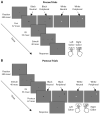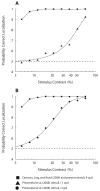Transient attention does increase perceived contrast of suprathreshold stimuli: a reply to Prinzmetal, Long, and Leonhardt (2008)
- PMID: 18979688
- PMCID: PMC2638121
- DOI: 10.3758/pp.70.7.1151
Transient attention does increase perceived contrast of suprathreshold stimuli: a reply to Prinzmetal, Long, and Leonhardt (2008)
Abstract
Carrasco, Ling, and Read (2004) showed that transient attention increases perceived contrast. However, Prinzmetal, Long, and Leonhardt (2008) suggest that for targets of low visibility, observers may bias their response toward the cued location, and they propose a cue-bias explanation for our previous results. Our response is threefold. First, we outline several key methodological differences between the studies that could account for the different results. We conclude that the cue-bias hypothesis is a plausible explanation for Prinzmetal et al.'s (2008) results, given the characteristics of their stimuli, but not for the studies by Carrasco and colleagues, in which the stimuli were suprathreshold (Carrasco, Ling, & Read, 2004; Fuller, Rodriguez, & Carrasco, 2008; Ling & Carrasco, 2007). Second, we conduct a study to show that the stimuli used in our previous studies are not near-threshold, but suprathreshold (Experiment 1, Phase 1). Furthermore, we found an increase in apparent contrast for a high-contrast stimulus when it was precued, but not when it was postcued, providing more evidence against a cue-bias hypothesis (Experiment 1, Phase 2). We also show that the visibility of the stimuli in Prinzmetal et al. (2008) was much lower than that of Carrasco, Ling, and Read, rendering their stimuli susceptible to their cue-bias explanation (Experiment 2). Third, we present a comprehensive summary of all the control conditions used in different labs that have ruled out a cue bias explanation of the appearance studies. We conclude that a cue-bias explanation may operate with near-threshold and low-visibility stimuli, as was the case in Prinzmetal et al. (2008), but that such an explanation has no bearing on studies with suprathreshold stimuli. Consistent with our previous studies, the present data support the claim that attention does alter the contrast appearance of suprathreshold stimuli.
Figures





Comment on
-
Involuntary attention and brightness contrast.Percept Psychophys. 2008 Oct;70(7):1139-50. doi: 10.3758/PP.70.7.1139. Percept Psychophys. 2008. PMID: 18927000
Similar articles
-
Cue contrast modulates the effects of exogenous attention on appearance.Vision Res. 2009 Jul;49(14):1825-37. doi: 10.1016/j.visres.2009.04.019. Epub 2009 Apr 22. Vision Res. 2009. PMID: 19393260 Free PMC article. Clinical Trial.
-
Involuntary attention and brightness contrast.Percept Psychophys. 2008 Oct;70(7):1139-50. doi: 10.3758/PP.70.7.1139. Percept Psychophys. 2008. PMID: 18927000
-
Transient covert attention does alter appearance: a reply to Schneider (2006).Percept Psychophys. 2007 Aug;69(6):1051-8. doi: 10.3758/bf03193943. Percept Psychophys. 2007. PMID: 18018987 Free PMC article.
-
Transient covert attention and the perceived rate of flicker.J Vis. 2006 Aug 18;6(9):955-65. doi: 10.1167/6.9.8. J Vis. 2006. PMID: 17083287
-
The Role of Perspective Taking on Attention: A Review of the Special Issue on the Reflexive Attentional Shift Phenomenon.Vision (Basel). 2019 Oct 9;3(4):52. doi: 10.3390/vision3040052. Vision (Basel). 2019. PMID: 31735853 Free PMC article. Review.
Cited by
-
Spatial attention alters visual appearance.Curr Opin Psychol. 2019 Oct;29:56-64. doi: 10.1016/j.copsyc.2018.10.010. Epub 2018 Nov 8. Curr Opin Psychol. 2019. PMID: 30572280 Free PMC article. Review.
-
P3b Does Not Reflect Perceived Contrasts.eNeuro. 2022 Apr 6;9(2):ENEURO.0387-21.2022. doi: 10.1523/ENEURO.0387-21.2022. Print 2022 Mar-Apr. eNeuro. 2022. PMID: 35346962 Free PMC article.
-
Equality judgments cannot distinguish between attention effects on appearance and criterion: a reply to Schneider (2011).J Vis. 2011 Nov 9;11(13):10.1167/11.13.8 8. doi: 10.1167/11.13.8. Print 2011. J Vis. 2011. PMID: 22072728 Free PMC article.
-
How visual spatial attention alters perception.Cogn Process. 2018 Sep;19(Suppl 1):77-88. doi: 10.1007/s10339-018-0883-4. Cogn Process. 2018. PMID: 30062667 Free PMC article. Review.
-
Cue contrast modulates the effects of exogenous attention on appearance.Vision Res. 2009 Jul;49(14):1825-37. doi: 10.1016/j.visres.2009.04.019. Epub 2009 Apr 22. Vision Res. 2009. PMID: 19393260 Free PMC article. Clinical Trial.
References
-
- Adelson EH. Lightness perception and lightness illusions. In: Gazzaniga M, editor. The new cognitive neurosciences. 2nd ed. MIT Press; Cambridge, MA: 2000. pp. 339–351.
-
- Alais D, Blake R. Neural strength of visual attention gauged by motion adaptation. Nature Neuroscience. 1999;2:1015–1018. - PubMed
-
- Anton-Erxleben K, Henrich C, Treue S. Attention changes perceived size of moving visual patterns. Journal of Vision. 2007;7(11 Art 5):1–9. - PubMed
-
- Bahrami B, Carmel D, Walsh V, Rees G, Lavie N. Unconscious orientation processing depends on perceptual load. Journal of Vision. 2008;8(3 Art 13):1–10. - PubMed
-
- Baldassi S, Burr DC. Feature-based integration of orientation signals in visual search. Vision Research. 2000;40:1293–1300. - PubMed
Publication types
MeSH terms
Grants and funding
LinkOut - more resources
Full Text Sources
Miscellaneous
